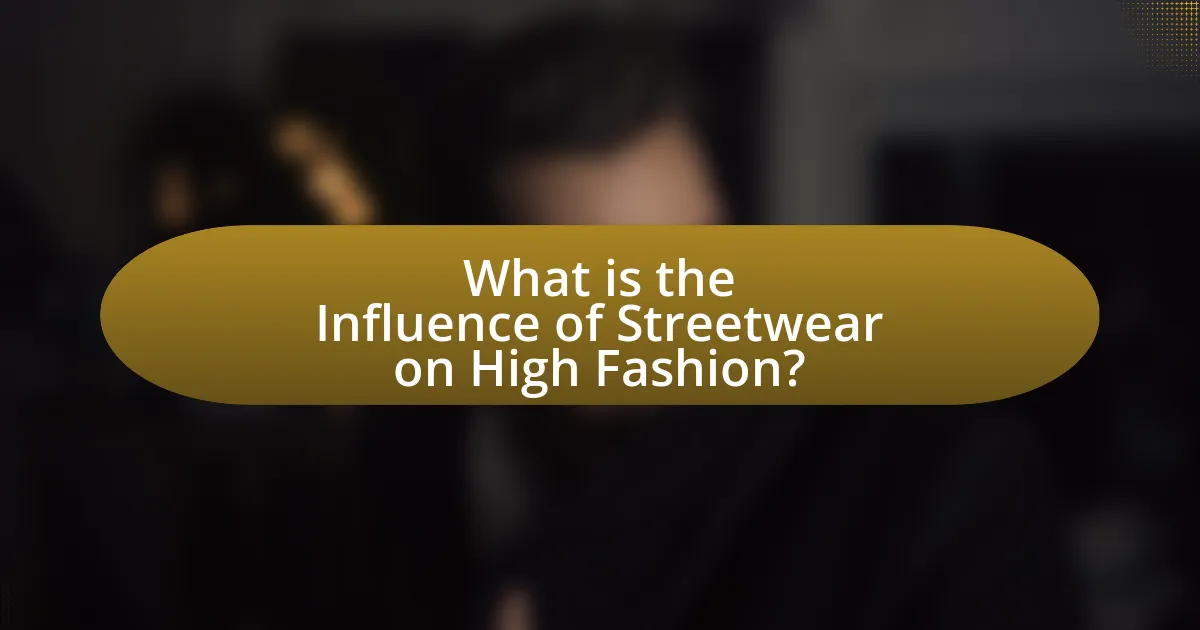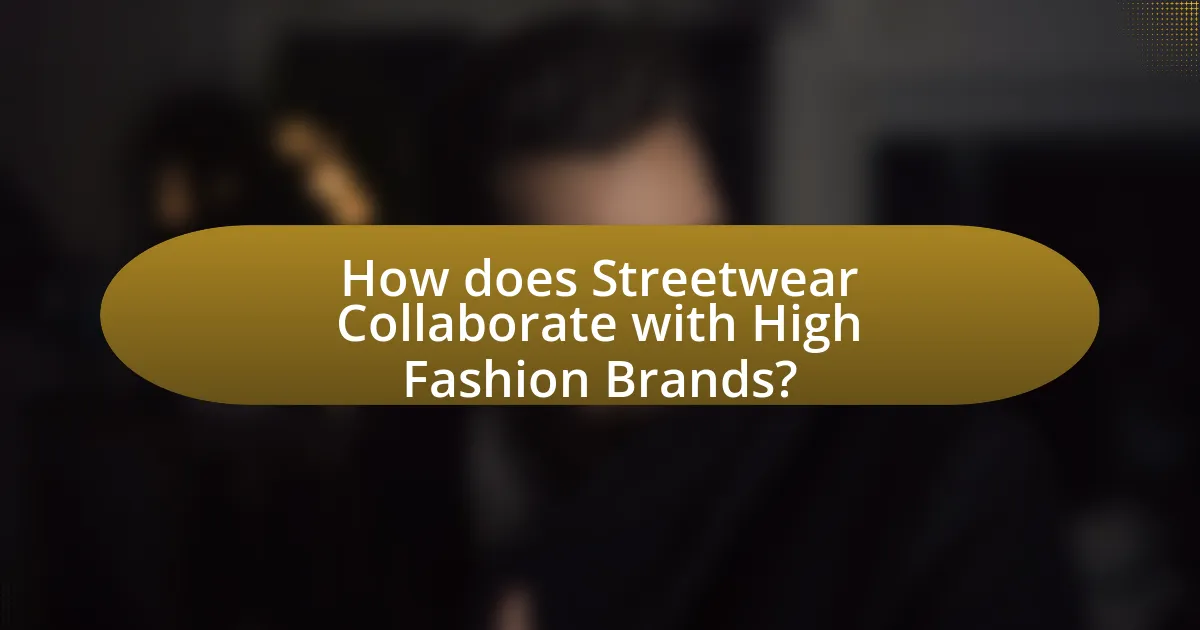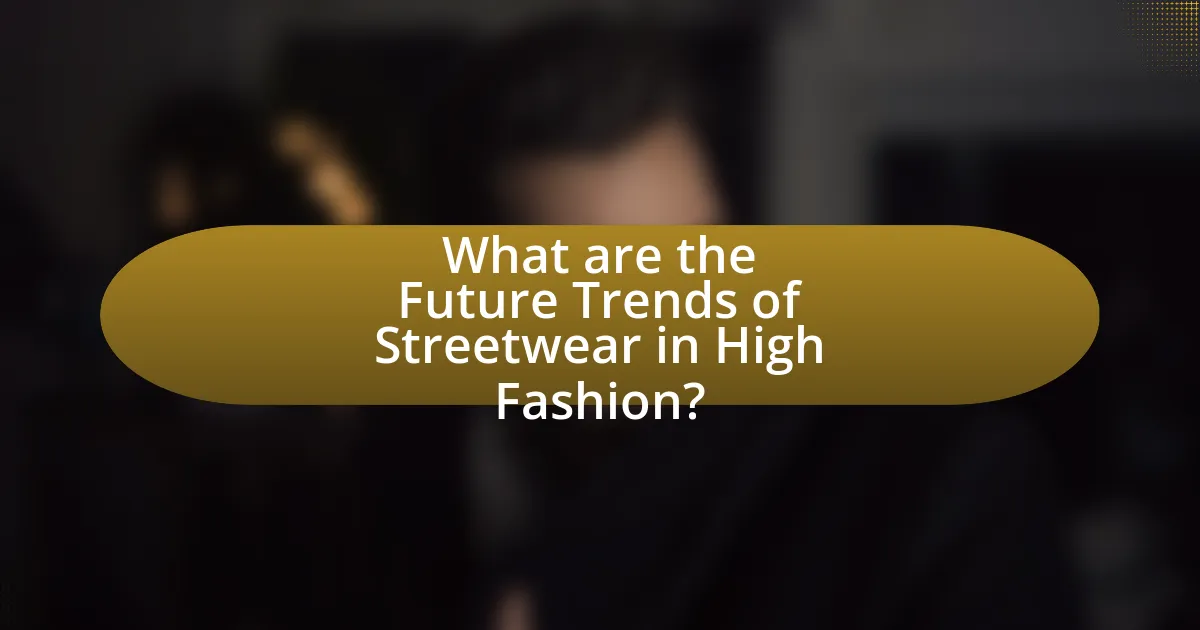The article examines the significant influence of streetwear on high fashion, highlighting how casual aesthetics, urban culture, and inclusivity have reshaped luxury design. It discusses the evolution of streetwear, tracing its roots from hip-hop and skate culture to its current status in the fashion industry, marked by collaborations between streetwear brands and high-end fashion houses. Key historical events, consumer attitudes, and cultural shifts that have facilitated this transformation are analyzed, along with the role of technology and sustainability in shaping future trends. The article also explores notable collaborations, emerging designers, and practical tips for consumers to integrate streetwear into their high fashion wardrobes.

What is the Influence of Streetwear on High Fashion?
Streetwear significantly influences high fashion by integrating casual aesthetics, urban culture, and inclusivity into luxury design. This fusion is evident in collaborations between streetwear brands and high-end fashion houses, such as the partnership between Off-White and Louis Vuitton, which showcases how streetwear’s relaxed styles and graphic designs have permeated luxury collections. Additionally, the rise of streetwear has shifted consumer expectations, leading high fashion brands to adopt more accessible pricing and diverse marketing strategies, reflecting the values of younger generations. The impact is further supported by the increasing presence of streetwear in major fashion weeks and its acceptance by high-profile designers, indicating a lasting transformation in the fashion landscape.
How has streetwear evolved to impact high fashion?
Streetwear has evolved to significantly impact high fashion by merging casual aesthetics with luxury branding, leading to a democratization of style. This evolution began in the late 20th century, with brands like Supreme and Off-White challenging traditional fashion norms and introducing street culture into high-end collections. The collaboration between streetwear labels and luxury houses, such as Louis Vuitton’s partnership with Virgil Abloh, exemplifies this shift, showcasing how streetwear influences design, marketing, and consumer engagement in high fashion. The rise of social media has further accelerated this trend, allowing streetwear to reach a global audience and reshape consumer expectations regarding exclusivity and accessibility in luxury fashion.
What historical events contributed to the rise of streetwear?
The rise of streetwear can be attributed to several key historical events, including the emergence of hip-hop culture in the 1980s, the influence of skateboarding and surf culture, and the commercialization of youth subcultures in the 1990s. Hip-hop culture, which began in New York City, popularized casual, oversized clothing and sneakers, establishing a new fashion aesthetic. Skateboarding and surf culture contributed to this by promoting brands like Vans and Stüssy, which emphasized comfort and individuality. Additionally, the 1990s saw major fashion brands begin to collaborate with streetwear labels, further legitimizing streetwear within the fashion industry. These events collectively shaped streetwear into a significant cultural and fashion movement.
How did streetwear brands gain recognition in the fashion industry?
Streetwear brands gained recognition in the fashion industry through a combination of cultural relevance, celebrity endorsements, and strategic collaborations. Initially rooted in skate and hip-hop culture, brands like Supreme and Off-White leveraged their grassroots appeal to connect with youth culture. The endorsement of celebrities and influencers, such as Kanye West and Rihanna, further propelled these brands into mainstream visibility. Additionally, collaborations with high-fashion houses, like Louis Vuitton’s partnership with Virgil Abloh, showcased streetwear’s legitimacy and influence, leading to its acceptance within luxury fashion. This blend of cultural authenticity and strategic marketing solidified streetwear’s position in the fashion landscape.
Why is streetwear considered a significant trend in high fashion?
Streetwear is considered a significant trend in high fashion because it merges casual, urban aesthetics with luxury design, appealing to a younger, fashion-forward demographic. This trend has gained traction as high fashion brands like Gucci and Balenciaga have incorporated streetwear elements into their collections, reflecting a shift in consumer preferences towards more relaxed and inclusive styles. The rise of social media and influencer culture has further amplified streetwear’s visibility, allowing brands to reach wider audiences and create a sense of community around their products. This cultural crossover has led to collaborations between streetwear labels and high fashion houses, solidifying streetwear’s status as a vital component of contemporary fashion.
What cultural shifts have influenced the acceptance of streetwear in high fashion?
The acceptance of streetwear in high fashion has been significantly influenced by the rise of youth culture and the democratization of fashion. Youth culture, particularly from the 1990s onwards, embraced casual and expressive clothing, which led to a shift in fashion norms that favored comfort and individuality over traditional luxury aesthetics. This cultural movement was further propelled by the influence of hip-hop and skateboarding communities, which popularized streetwear brands like Supreme and Off-White, making them symbols of status and identity.
Additionally, the advent of social media has played a crucial role in this acceptance, allowing streetwear brands to reach a global audience and enabling consumers to engage directly with fashion trends. Platforms like Instagram have blurred the lines between high fashion and streetwear, as influencers and celebrities showcase streetwear styles alongside luxury brands, thus validating their place in high fashion. This shift is evidenced by collaborations between high-end designers and streetwear labels, such as Louis Vuitton’s partnership with Virgil Abloh, which further legitimized streetwear within the luxury market.
How do consumer attitudes towards fashion affect this influence?
Consumer attitudes towards fashion significantly shape the influence of streetwear on high fashion. When consumers embrace streetwear as a legitimate fashion category, it encourages high fashion brands to incorporate streetwear elements into their collections. For instance, a 2020 study by the Fashion Institute of Technology found that 70% of millennials view streetwear as a key trend, prompting luxury brands like Gucci and Balenciaga to adopt casual styles and urban aesthetics. This shift reflects a broader acceptance of diverse fashion expressions, driven by consumer demand for authenticity and relatability in high fashion.
What are the key characteristics of streetwear that appeal to high fashion?
The key characteristics of streetwear that appeal to high fashion include its emphasis on casual aesthetics, cultural relevance, and exclusivity. Streetwear often incorporates bold graphics, oversized silhouettes, and unique materials, which resonate with high fashion’s trendsetting nature. Additionally, the cultural narratives and social movements associated with streetwear create a sense of authenticity and connection that high fashion brands seek to leverage. The limited-edition drops and collaborations typical in streetwear foster a sense of urgency and desirability, aligning with high fashion’s luxury appeal.
How does the aesthetic of streetwear differ from traditional high fashion?
The aesthetic of streetwear is characterized by casual, urban styles that prioritize comfort and functionality, while traditional high fashion emphasizes luxury, exclusivity, and intricate design. Streetwear often incorporates graphic tees, hoodies, and sneakers, reflecting a more relaxed and accessible approach, whereas high fashion typically features tailored silhouettes, high-quality materials, and elaborate craftsmanship. This distinction is evident in the way streetwear brands like Supreme and Off-White utilize bold graphics and cultural references, contrasting with high fashion houses such as Chanel and Dior, which focus on timeless elegance and meticulous detailing.
What role does branding play in the success of streetwear within high fashion?
Branding is crucial to the success of streetwear within high fashion as it establishes identity, exclusivity, and cultural relevance. Strong branding allows streetwear labels to differentiate themselves in a saturated market, creating a loyal customer base that values authenticity and lifestyle alignment. For instance, brands like Supreme have leveraged limited releases and collaborations with high-profile designers to enhance their brand prestige, resulting in a valuation of over $1 billion. This demonstrates that effective branding not only drives consumer demand but also elevates streetwear to a status symbol within high fashion, influencing trends and market dynamics.

How does Streetwear Collaborate with High Fashion Brands?
Streetwear collaborates with high fashion brands through limited-edition collections, co-branded products, and innovative marketing strategies. This collaboration often merges streetwear’s casual aesthetics with high fashion’s luxury appeal, creating unique offerings that attract diverse consumer bases. For instance, the partnership between Supreme and Louis Vuitton in 2017 exemplifies this trend, where streetwear’s cultural relevance and high fashion’s prestige combined to generate significant buzz and sales, with items selling out rapidly and reselling for much higher prices. Such collaborations not only elevate streetwear’s status but also allow high fashion brands to tap into the youth market, demonstrating the mutual benefits of these partnerships.
What are some notable collaborations between streetwear and high fashion brands?
Notable collaborations between streetwear and high fashion brands include the partnership between Supreme and Louis Vuitton, which launched in 2017 and featured a collection that combined streetwear aesthetics with luxury fashion, resulting in high demand and resale value. Another significant collaboration is the collaboration between Off-White and Nike, which began in 2017, where Virgil Abloh reimagined classic Nike silhouettes, blending streetwear culture with high-end design, leading to widespread acclaim and commercial success. Additionally, the collaboration between Yeezy, designed by Kanye West, and Adidas has transformed sneaker culture, merging streetwear with high fashion, particularly with the Yeezy Boost line, which has become a cultural phenomenon since its debut in 2015.
How do these collaborations redefine brand identities?
Collaborations between streetwear and high fashion brands redefine brand identities by merging distinct cultural elements and appealing to diverse consumer bases. This fusion allows high fashion brands to adopt a more casual, accessible image, while streetwear brands gain prestige and visibility in luxury markets. For instance, the collaboration between Louis Vuitton and Off-White, led by Virgil Abloh, not only elevated Off-White’s status but also infused Louis Vuitton with a contemporary, youthful vibe, attracting a new demographic of consumers. Such partnerships demonstrate how blending styles can reshape perceptions, enhance brand relevance, and drive innovation in the fashion industry.
What impact do collaborations have on consumer perception?
Collaborations significantly enhance consumer perception by associating brands with innovation and exclusivity. When high-fashion labels partner with streetwear brands, they tap into a younger, trend-savvy demographic, which can elevate their image and broaden their market reach. For instance, the collaboration between Louis Vuitton and Supreme in 2017 generated immense buzz and increased brand visibility, leading to a reported 25% increase in sales for Louis Vuitton in the following year. This demonstrates that strategic collaborations can reshape consumer attitudes, making luxury brands appear more accessible and relevant in contemporary culture.
Why do high fashion brands seek partnerships with streetwear labels?
High fashion brands seek partnerships with streetwear labels to tap into the growing youth culture and expand their market reach. Collaborating with streetwear allows luxury brands to attract a younger demographic that values authenticity and casual aesthetics, which are hallmarks of streetwear. For instance, the collaboration between Louis Vuitton and Off-White’s Virgil Abloh in 2018 generated significant buzz and sales, illustrating how such partnerships can rejuvenate a brand’s image and relevance in a rapidly evolving fashion landscape. This strategic alignment not only enhances brand visibility but also fosters innovation by blending high fashion’s craftsmanship with streetwear’s urban appeal.
What benefits do high fashion brands gain from streetwear collaborations?
High fashion brands gain increased market reach and relevance through streetwear collaborations. These partnerships allow luxury brands to tap into the growing streetwear demographic, which is often younger and more diverse. For instance, the collaboration between Louis Vuitton and Off-White’s Virgil Abloh in 2018 not only generated significant media buzz but also attracted a new customer base, leading to a reported 20% increase in sales for Louis Vuitton. Additionally, such collaborations enhance brand image by associating high fashion with contemporary culture, making luxury more accessible and appealing to a broader audience.
How do streetwear brands leverage high fashion partnerships for growth?
Streetwear brands leverage high fashion partnerships for growth by enhancing their brand visibility and credibility through association with established luxury labels. These collaborations often result in limited-edition collections that create buzz and drive demand, as seen in the partnership between Supreme and Louis Vuitton, which generated significant media attention and increased sales for both brands. Additionally, such partnerships allow streetwear brands to tap into high fashion’s affluent customer base, expanding their market reach and elevating their brand perception. This strategy not only boosts revenue but also solidifies their position within the fashion industry, as evidenced by the rise of brands like Off-White, which gained prominence through collaborations with high-end designers.

What are the Future Trends of Streetwear in High Fashion?
The future trends of streetwear in high fashion include increased collaboration between luxury brands and streetwear labels, a focus on sustainability, and the integration of technology in fashion. Collaborations, such as those seen with brands like Off-White and Louis Vuitton, demonstrate how high fashion is embracing streetwear aesthetics to attract younger consumers. Sustainability is becoming a priority, with brands like Gucci and Stella McCartney leading initiatives to create eco-friendly collections, reflecting a growing consumer demand for responsible fashion. Additionally, the use of technology, including augmented reality and digital fashion shows, is reshaping how streetwear is presented and consumed, as evidenced by the rise of virtual fashion platforms. These trends indicate that streetwear will continue to significantly influence high fashion, merging casual styles with luxury elements.
How is technology influencing the future of streetwear in high fashion?
Technology is significantly influencing the future of streetwear in high fashion by enabling innovative design processes, enhancing consumer engagement, and facilitating sustainable practices. Advanced technologies such as 3D printing and digital design software allow designers to create unique, intricate pieces that blend streetwear aesthetics with high fashion craftsmanship. Additionally, the rise of social media and e-commerce platforms has transformed how brands connect with consumers, allowing for real-time feedback and trend adaptation. For instance, brands like Off-White and Balenciaga leverage digital marketing strategies to engage younger audiences, driving the fusion of streetwear and luxury. Furthermore, technology is promoting sustainability through practices like on-demand production, which reduces waste and aligns with the growing consumer demand for eco-friendly fashion. This integration of technology not only shapes the design and marketing of streetwear but also redefines its role within the high fashion landscape.
What role does social media play in shaping future trends?
Social media significantly influences the shaping of future trends by providing a platform for rapid dissemination and engagement with new ideas and styles. It allows brands and influencers to showcase streetwear, which has become a dominant force in high fashion, reaching vast audiences instantly. For instance, a study by the Pew Research Center indicates that 72% of the public uses some form of social media, making it a critical tool for trendsetting. This widespread usage enables trends to emerge and evolve quickly, as users share and interact with content, leading to viral phenomena that can redefine fashion norms.
How are sustainability and ethical practices affecting streetwear’s evolution?
Sustainability and ethical practices are significantly shaping the evolution of streetwear by driving brands to adopt eco-friendly materials and transparent supply chains. This shift is evident as many streetwear labels, such as Patagonia and Stella McCartney, prioritize sustainable sourcing and ethical labor practices, responding to consumer demand for responsible fashion. According to a 2021 report by McKinsey & Company, 67% of consumers consider sustainability when making a purchase, indicating a strong market trend towards environmentally conscious choices. As a result, streetwear is increasingly integrating recycled fabrics and promoting circular fashion, which not only enhances brand loyalty but also aligns with broader societal values regarding environmental responsibility.
What emerging designers are shaping the future of streetwear in high fashion?
Emerging designers shaping the future of streetwear in high fashion include Telfar Clemens, known for his unisex designs and accessibility, and Marine Serre, recognized for her innovative use of upcycled materials and distinctive crescent moon motifs. Telfar’s brand gained significant attention with the “Bushwick Birkin,” a bag that emphasizes inclusivity and democratization in fashion, while Marine Serre’s collections often blend streetwear aesthetics with high fashion techniques, showcasing a commitment to sustainability. Both designers are redefining the boundaries of streetwear within the luxury market, influencing trends and consumer expectations.
How do these designers challenge traditional fashion norms?
Designers challenge traditional fashion norms by integrating streetwear elements into high fashion, thereby blurring the lines between casual and formal attire. This shift is evident in the use of oversized silhouettes, bold graphics, and unconventional materials, which disrupt established aesthetics and promote inclusivity. For instance, brands like Off-White and Supreme have successfully merged luxury with everyday wear, attracting a diverse audience and redefining consumer expectations. This approach not only democratizes fashion but also encourages self-expression, as seen in the rise of personalized styles among consumers.
What innovations are they bringing to the streetwear scene?
They are introducing sustainable materials and technology-driven designs to the streetwear scene. Brands like A Bathing Ape and Off-White are utilizing eco-friendly fabrics and innovative production techniques, such as 3D printing, to reduce environmental impact while enhancing aesthetic appeal. This shift towards sustainability is evidenced by the increasing number of collaborations between streetwear brands and environmental organizations, highlighting a commitment to responsible fashion.
What practical tips can consumers follow to incorporate streetwear into their high fashion wardrobe?
Consumers can incorporate streetwear into their high fashion wardrobe by blending casual pieces with luxury items. For instance, pairing a designer blazer with graphic tees or joggers creates a balanced look that merges both styles. Additionally, investing in statement sneakers can elevate an outfit, as they are a staple in streetwear and complement high-end fashion. Layering streetwear essentials, like hoodies or oversized jackets, under tailored coats also adds depth to the ensemble. This approach reflects the current trend where high fashion brands, such as Balenciaga and Off-White, frequently integrate streetwear elements into their collections, demonstrating the successful fusion of these two styles.

Leave a Reply